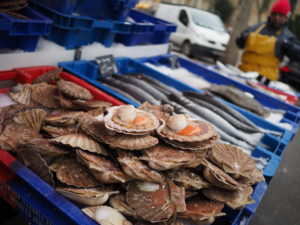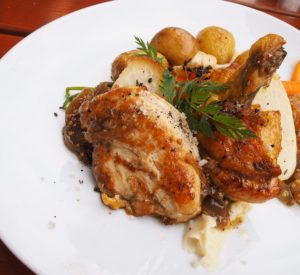Each year I have traditions revolving around food. It starts in late winter with my annual spring garden planning, to the start of the local farmers’ markets. Late spring is such an exciting time for those of us who enjoy eating local in New England. The launch of those seasonal menus pulls us from the winter doldrums with a peak at the first bright early greens of the season. It is a reawakening of our sleepy taste buds!
Getting a true taste of the foods grown and produced in a region means getting a true taste of a culture.
This year I am on the road, traveling through Europe and missing those first tastes of spring and summer back home. As my friends post photos of fiddleheads and spring asparagus, I’m having some serious market envy. However, just because I’m living throughout Europe for the year doesn’t mean that I must completely miss out on local seasonal foods.
When I am in another country, I don’t want to eat food from the United States. I want to eat local food from Germany, Bulgaria, or Italy. Getting a true taste of the foods grown and produced in a region means getting a true taste of a culture.

I’ve found that with a little online research – it isn’t too difficult to find the markets that have local foods. I’ve also found a number of localvore restaurants as well! The ease in finding locally grown food has varied from city and country, but generally, I am always successful in finding something!
“There’s a ton of local places to eat”
To those who aren’t aware that “eating local” is a thing, you might get told that there are a lot of local restaurants in the area. Maybe they’ll recommend looking on the internet to find the restaurants that are in the neighborhood. There’s a McDonalds down the street!
(McDonalds and KFC are all over Europe by the way.)
THAT isn’t what eating local means.
Eating Local – What to Look For
Localvore, Local Food, Slow Food, Farm-to-Fork, Farm-to-Table – these are all terms that roughly mean the same thing, which is supporting producers (meat, dairy, produce, etc) who are within your local communities. The different names sprouted out from the two major local food movements that started in the 1970s and 1980s.
When looking for a restaurant that supports local producers, they may not advertise as Slow Food or Farm-to-Table. Before fast food was a thing, slow was much more the normal traditional way of preparing foods. One way to locate these places is to look for those with seasonal or daily menus. Often this can lead you closer to the local food supporters.

What IS Slow Food?
Slow Food is to Europe what “Farm-to-Table” and “Eat Local” are to the United States. The Slow Food Movement began in Italy in 1989 by Carlo Petrini. His movement began as a protest to the opening of a McDonalds near to the Spanish Steps in Rome. Tired of the widespread growth of “Fast Food” and the loss of cultural cuisine, Slow Food embraced local producers, local products, and the preservation of culturally significant culinary preparations.
The Globalization of the Local Food Movement
Today the two concepts; Farm-to-Table and Slow Food, have become globally synonymous with the ideas of Eating Local. Together these concepts form a more global local food movement of eating closer to “the source”.
The ease in finding locally grown food has varied from city and country, but generally, I am always successful in finding something!
Reasons vary for supporting the local food movement.
Economic – keeping money in one’s community.
Environmental – reducing environmental impacts by choosing organic and locally transported products.
Taste – seeking the freshest and most seasonally appropriate products, picked at peak ripeness.
The motivation for supporting the movement doesn’t seem to matter, what is apparent though is that the movement isn’t slowing down.
The Economics of Organic and Local Foods
The growing interest in the organic and local food markets can be seen in consumer spending around the globe. In the U.S. alone – local foods generated approximately $12B in sales in 2014. This figure is projected to nearly double by 2019, reaching roughly $20B.
European data isn’t as transparent. Local is usually hidden within larger studies of the overall organic and natural foods market. The numbers are still quite telling, and show significant continued growth. Since 2012 the European organic foods market has grown 13% while per capita spending has doubled to $40 (USD equiv.).
European Struggles to Overcome
While in the United States the local food movement has thrived, Europe has had more struggles. In the U.S., eating local has begun to become less a trend and more of the standard. This is true at least for many of the chefs and individuals I personally know. Meanwhile, the global economic crisis has provided significant challenges for the European local and organic food market. Similar to the United States, consumers are value driven, particularly at a time when some of these countries are still struggling to rebound from the crisis
Similar to the United States, consumers in Europe are value driven, particularly at a time when some of these countries are still struggling to rebound from the crisis ten years ago. Couple the economics of consumer cost with the economics of product transport, when some farmers and producers may not have ways to get their products to the larger markets, and you can see that there are still significant problems that need to be overcome. This is one of the powerful benefits that tourism can provide.

Responsible Tourism
This is one of the powerful benefits that responsible tourism can provide. When traveling, choose small local businesses as often as possible. Choose local markets, farmers, bakers, and producers as often as possible.
No judgment if you want a taste from home now and again. I’ve been traveling for four months now and I’ve had a couple Frappucinos. Sometimes you need a familiar connection, I get that. However, traveling is best when it shows you a window into another culture.
I believe that what makes traveling so powerful is experiencing the uniqueness of the region, and the best way to do that is to get to know the locals and eat from their land! Stay tuned as I review Slow Food restaurants I’ve eaten at in Bulgaria, Germany, and more.
Safe and tasty traveling to everyone!
